
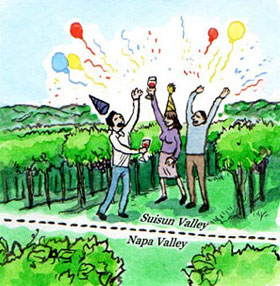
Suisun Valley is enjoying a 'coming out' party of sorts -- a quarter century after receiving AVA status.
Suisun Valley: It's closer to Napa than you think
“The fact that this area is so close to Napa Valley, and with soils that are quite a bit like Napa, indicates that we should be able to make excellent wine here on a regular basis,”
~ Larry Langbehn, Ledgewood Creek
by
Dan Berger
October 24, 2006
The name is spelled Suisun, but locals pronounce it suh-SOON, with the accent on the second syllable, as if someone were saying, “Why are you leaving so-soon?”
Still, it’s only a minor stumbling block to this mature wine region’s coming out party. Nothing compared with the fact that, nearing the 24th anniversary of its establishment as an American Viticulture Area (AVA) by the federal government, the region has fewer than nine wineries, has only recently hired a publicist, and is basically unknown.
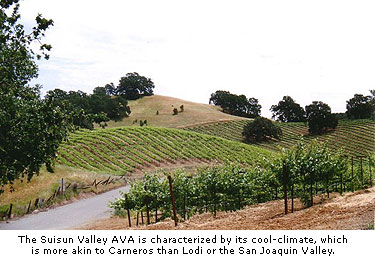 If you asked 1,000 dedicated wine crazies where it is, maybe one could tell you. Talk about flying under the radar.
If you asked 1,000 dedicated wine crazies where it is, maybe one could tell you. Talk about flying under the radar.
Yet it’s a region that intrigues wine makers all over the state who like reasonably priced, cooler-climate fruit to blend into wines that might include fruit from the central San Joaquin Valley (hot), Lodi (not quite so warm), and elsewhere. The local talking point is that the majority of vineyards here grow in conditions not unlike those found in Carneros.
So the area’s grapes are usually trucked out of Solano County, and thus do the names of the county and the AVA evaporate into blends.
Suisun Valley is in Solano County, one of California’s 58 counties. So let’s track down those 1,000 folks we polled earlier and give them the hint that Suisun is there. Do they know where there is?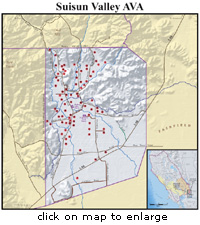
Solano County is a handsome agricultural zone a bit north and east of Vallejo, just south of Napa, and lying within a belt of cool air coming in from two bays, San Pablo Bay and Suisun Bay. If you drive Highway 80 east from Berkeley toward Sacramento, you’ll run right through Suisun Valley, which is itself adjacent to Solano County Green Valley, another inconspicuous AVA that lies due west and also south of Napa.
Roughly six miles long and two miles across, Suisun Valley remains potentially a superb wine-growing region, and with some 3,000 acres already in the ground, it is a resource for many. Even in the warmer spots, the area actually has about the same weather conditions as most of Napa Valley, but it varies (as does Napa) from north to south.
Larry Langbehn has made wine for 30 years at prestigious Napa Valley wineries, and now is wine maker at Ledgewood Creek, one of the largest wineries in the appellation. It is his belief that Suisun Valley has enormous potential to make a wide variety of wines. But, he says, it’s early in the process and the best sites for each grape variety have yet to be identified.
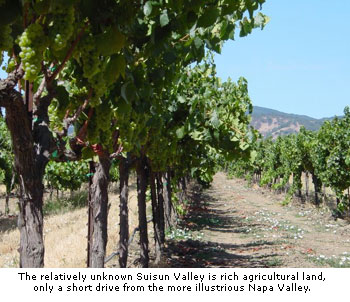 “It’s actually quite cool in the south-western quadrant (of the region),” he said recently. “It gets a lot warmer the further north you go. And we don’t get any of the fog that they get in regions closer to the ocean,” a climatic condition that means damaging rot is rarely an issue.
“It’s actually quite cool in the south-western quadrant (of the region),” he said recently. “It gets a lot warmer the further north you go. And we don’t get any of the fog that they get in regions closer to the ocean,” a climatic condition that means damaging rot is rarely an issue.
The soils here are Brentwood clay loam, silty clay loam, sandy loam, and Rincon clay loam, and provide local fruit and vegetable growers with a perfect substrate in which to grow a huge array of groceries. Much of this is targeted toward roadside fruit stands as well as gourmet restaurants in San Francisco.
Langbehn has been making wine for the last three years at Ledgewood Creek, for owners Dean and Bunny Frisbie, and he has a fascinating variety of wines that demonstrate the potential for the region.
His Viognier isn’t as tropical or floral as some, but has ample flavors. His Chardonnay is also more delicate, but has attractive fruit. Best bet thus far seems to be the Merlot, a wine with a distinctive tea-leaf and cherry personality. There is also a red Rhône blend, an excellent Cabernet Sauvignon, and a Sauvignon Blanc with distinctive aromatic qualities.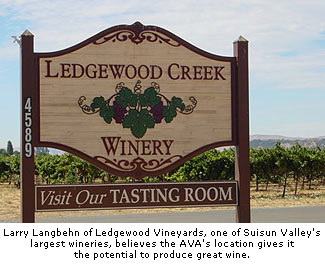
The Cabernet Sauvignons thus far are interesting, if a bit angular, and Langbehn believes they are simply in need of a year or two in the bottle to develop.
One of the problems Suisun has faced is the lack of hard data on which to make planting and harvesting decisions. Until 1998, the AVA had no weather stations and it wasn’t until 2005 that it added a station in the cooler southwestern quadrant. A quadrant, incidentally, which appears to have great conditions for making top-flight wine.
This past April, the region bought four new weather stations, bringing the area’s total to six. They were set up in the most arable areas north to south, and within a year should allow for creation of a chart showing the temperature gradients which are so crucial to making the right planting and harvesting decisions.
Among the other wineries here, besides Ledgewood Creek Winery, are Mankas Hills Vineyards, Vezer Family Vineyard, Wooden Valley Winery, Croze, Olabisi Wines, Sunset Cellars, Thomas Michael, and
Still, it’s only a minor stumbling block to this mature wine region’s coming out party. Nothing compared with the fact that, nearing the 24th anniversary of its establishment as an American Viticulture Area (AVA) by the federal government, the region has fewer than nine wineries, has only recently hired a publicist, and is basically unknown.
 If you asked 1,000 dedicated wine crazies where it is, maybe one could tell you. Talk about flying under the radar.
If you asked 1,000 dedicated wine crazies where it is, maybe one could tell you. Talk about flying under the radar.Yet it’s a region that intrigues wine makers all over the state who like reasonably priced, cooler-climate fruit to blend into wines that might include fruit from the central San Joaquin Valley (hot), Lodi (not quite so warm), and elsewhere. The local talking point is that the majority of vineyards here grow in conditions not unlike those found in Carneros.
So the area’s grapes are usually trucked out of Solano County, and thus do the names of the county and the AVA evaporate into blends.
Suisun Valley is in Solano County, one of California’s 58 counties. So let’s track down those 1,000 folks we polled earlier and give them the hint that Suisun is there. Do they know where there is?

Solano County is a handsome agricultural zone a bit north and east of Vallejo, just south of Napa, and lying within a belt of cool air coming in from two bays, San Pablo Bay and Suisun Bay. If you drive Highway 80 east from Berkeley toward Sacramento, you’ll run right through Suisun Valley, which is itself adjacent to Solano County Green Valley, another inconspicuous AVA that lies due west and also south of Napa.
Roughly six miles long and two miles across, Suisun Valley remains potentially a superb wine-growing region, and with some 3,000 acres already in the ground, it is a resource for many. Even in the warmer spots, the area actually has about the same weather conditions as most of Napa Valley, but it varies (as does Napa) from north to south.
Larry Langbehn has made wine for 30 years at prestigious Napa Valley wineries, and now is wine maker at Ledgewood Creek, one of the largest wineries in the appellation. It is his belief that Suisun Valley has enormous potential to make a wide variety of wines. But, he says, it’s early in the process and the best sites for each grape variety have yet to be identified.
 “It’s actually quite cool in the south-western quadrant (of the region),” he said recently. “It gets a lot warmer the further north you go. And we don’t get any of the fog that they get in regions closer to the ocean,” a climatic condition that means damaging rot is rarely an issue.
“It’s actually quite cool in the south-western quadrant (of the region),” he said recently. “It gets a lot warmer the further north you go. And we don’t get any of the fog that they get in regions closer to the ocean,” a climatic condition that means damaging rot is rarely an issue.The soils here are Brentwood clay loam, silty clay loam, sandy loam, and Rincon clay loam, and provide local fruit and vegetable growers with a perfect substrate in which to grow a huge array of groceries. Much of this is targeted toward roadside fruit stands as well as gourmet restaurants in San Francisco.
Langbehn has been making wine for the last three years at Ledgewood Creek, for owners Dean and Bunny Frisbie, and he has a fascinating variety of wines that demonstrate the potential for the region.
His Viognier isn’t as tropical or floral as some, but has ample flavors. His Chardonnay is also more delicate, but has attractive fruit. Best bet thus far seems to be the Merlot, a wine with a distinctive tea-leaf and cherry personality. There is also a red Rhône blend, an excellent Cabernet Sauvignon, and a Sauvignon Blanc with distinctive aromatic qualities.

The Cabernet Sauvignons thus far are interesting, if a bit angular, and Langbehn believes they are simply in need of a year or two in the bottle to develop.
One of the problems Suisun has faced is the lack of hard data on which to make planting and harvesting decisions. Until 1998, the AVA had no weather stations and it wasn’t until 2005 that it added a station in the cooler southwestern quadrant. A quadrant, incidentally, which appears to have great conditions for making top-flight wine.
This past April, the region bought four new weather stations, bringing the area’s total to six. They were set up in the most arable areas north to south, and within a year should allow for creation of a chart showing the temperature gradients which are so crucial to making the right planting and harvesting decisions.
Discover the Suisun Valley for yourself!

Buy wines direct from Suisun Valley wineries in Appellation America’s online wine store.
“The fact that this area is so close to Napa Valley, and with soils that are quite a bit like Napa, indicates that we should be able to make excellent wine here on a regular basis,” said Langbehn.
Buy wines direct from Suisun Valley wineries in Appellation America’s online wine store.
Among the other wineries here, besides Ledgewood Creek Winery, are Mankas Hills Vineyards, Vezer Family Vineyard, Wooden Valley Winery, Croze, Olabisi Wines, Sunset Cellars, Thomas Michael, and
Print this article | Email this article | More about Suisun Valley | More from Dan Berger













